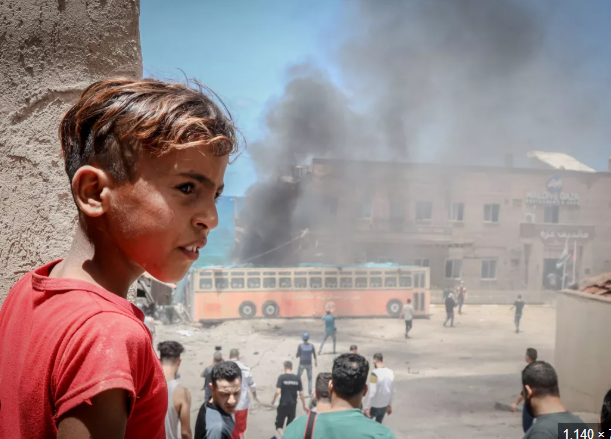Abla al-Alami – Gaza
11-year-old Maryam al-Majaiyda sits silently in a corner of the tent, confused, trying to make sense of the chaos around her. With a trembling voice, she says:
“Every time I turn on the phone, they say things—I don’t know if they’re true or not… They say there’s a ceasefire, but I still hear bombing outside… Why are they lying to us?”
Her mother confirms that Maryam has become disoriented, unable to distinguish between truth and rumor, or to believe anything she hears.
Maryam now suffers from frequent headaches, eating disorders, and persistent nighttime crying. On top of that, she has lost trust in her surroundings and constantly feels excluded. She repeats the news she hears as if each headline were a real and imminent threat.
Maryam’s experience is not unique. Most children in Gaza who follow the news—and repeatedly hear that the war is nearly over, that aid is steadily flowing, and that famine is ending—are becoming aware of a major gap between media narratives and lived reality.
The truth is, the war is not nearly over, aid is not arriving consistently, and famine still looms. But what’s even more damaging is the psychological toll this misinformation takes on children. Media distortion doesn’t just twist facts—it infiltrates a child’s awareness, creating a profound sense of confusion and internal conflict.
Local reports and interviews with families in Gaza reveal a troubling trend: many children are now exhibiting behavioral issues such as social withdrawal, nightmares, bedwetting, and emotional suppression. In a displacement camp in Khan Younis, Um Al-Abed, a mother of four, says:
“My ten-year-old son asks me: Why doesn’t the world see us? The images he sees on social media—so far removed from our reality—make him feel invisible, as if his pain doesn’t exist.”
At one of Gaza’s schools still functioning despite the war, teacher Lamia explains that displaced children begin their lessons by talking about the latest news on deals and aid convoys.
“They’re deeply affected by changing headlines,” she says. “When a classmate is killed, it’s not just sadness—it’s a deep sense that no one cares. They always say to me: ‘We only have God, miss.’”
This distorted awareness reflects a larger issue absent from most media coverage: children lack the analytical tools needed to differentiate between truth, propaganda, or manipulation. As a result, misinformation targeting them often causes serious emotional harm.
Misinformation doesn’t only lie in what is omitted or falsified—it also lies in how information is presented to children. This includes:
-Reducing children to statistics with no mention of their stories.
-Broadcasting contradictory news about aid and ceasefires, eroding trust.
-Sharing graphic images with no human context, sowing fear instead of understanding.
-Repeating political narratives in language far beyond their comprehension.
-Publishing posts that deny or justify their suffering, leading to internal confusion and emotional detachment.
Such content leaves lasting marks—it disrupts sleep patterns, social behavior, emotional development, and even a child’s sense of identity.
A child who sees themselves in the news with no voice, no agency, and no dignity becomes trapped in a dual trauma: the trauma of war and the trauma of being ignored.
Psychologist Dr. Nawal Asqoul explains that media misinformation creates a psychological disconnect between children and their reality.
“They begin to question their own feelings and experiences,” she says. “Children often internalize distorted narratives because they lack the critical capacity to challenge them. This can lead to anxiety, depression, hypersensitivity, and profound distrust of their environment. These symptoms can eventually develop into severe disorders, like bipolarity or internal crises.”
As technology enters every home, social media platforms have shifted from being a window to the world into spaces that expose children to decontextualized images—turning them into nameless victims, stripped of their true voices. This contributes to a sense of unreality and mental alienation.
What childhood in Gaza needs is not clickbait content or fleeting sympathy, but journalism that truly sees and hears the child—media that tells their stories with honesty and humanity.
Gazan children don’t need a trending hashtag.
They need a moral awakening—one that documents their truth and rebuilds their understanding of the world beyond the harsh narratives trapping their spirit.
